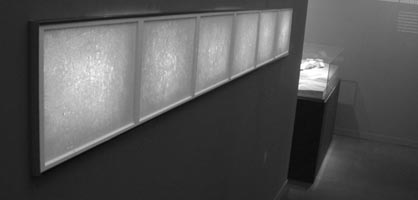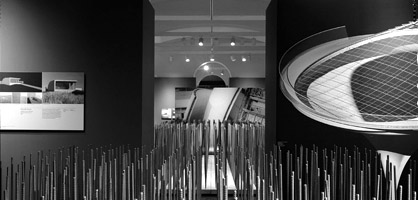|
sito + "/AREA=" + sezione + "/AAMSZ=" + misura + "/ACC_RANDOM=" + bumber + "/PAGEID=" + pageid + "'>"); document.write(""); |
| home > allestimenti |
|
sito + "/AREA=" + sezione + "/AAMSZ=" + misura + "/ACC_RANDOM=" + bumber + "/PAGEID=" + pageid + "'>"); document.write(""); |
| home > allestimenti |
| Liquid
Stone: New Architecture in Concrete Martin Moeller |
||||
| In
an age when architects aspire to an ever increasing immateriality and
lightness in construction, it is significant that the National Building
Museum in Washington DC is hosting a series of ongoing exhibitions that
explore the design and cultural implications of specific building materials:
wood, stone and, the latest, concrete. As if to remind us that materiality,
after all, is one of the fundamental elements of architecture. All this
is achieved in a very thoughtful and inventive way by the exhibit curator,
Martin Moeller, who skillfully avoids a historical survey of the architectural
uses of concrete while focusing on a series of innovative and experimental
contemporary projects. Tod Williams and Billie Tsien are known to the
international public for their rigorous and delicate intervention at
the Neuroscience Institute in La Jolla, next to Kahn's Salk Institute,
and for the more recent Natatorium at Cranbrook Academy and the Museum
of American Folk Art in New York City. As architects in charge of the
Liquid Stone exhibit design, they put a very clear and distinctive idea
in practice: they employed the basic components of concrete (panels
and rebars) in order to create a meditative and unifying landscape,
a muted backdrop that offers the visitor a contemplative atmosphere
to appreciate the starkly beautiful photographs, models and artifacts
arranged through the enfilade of the museum's galleries. Martin Moeller,
curator of the exhibit, and Billie Tsien
with Jennifer Turner of Tod Williams Billie Tsien Architects present
for ARCH'IT their integrated effort in producing this attractive exhibit:
a fruitful collaboration to be hoped for. [PG] |
||||
Materiality
is one of the fundamental elements of architecture. A given material's
scale, pattern, color, texture, and form -whether intrinsic or wrought
by the human hand- substantially determine the ultimate character of
a finished building. Indeed, the history of architecture is, to a large
extent, a history of changing attitudes, assumptions, and technologies
related to the use of particular materials. With this in mind, the National Building Museum in Washington, DC, has developed an ongoing series of exhibitions examining the design and cultural implications of specific building materials. One previous exhibition, for example, explored the longstanding American affinity for using wood as the predominant structural and finish material in residential architecture. Another, called Masonry Variations, presented four custom installations by teams of architects and master craftspeople that tested traditional assumptions about the limitations of stone, brick, and other forms of masonry. Liquid Stone: New Architecture in Concrete is the latest exhibition in the series. As curator of this exhibition, I was eager to avoid a historical survey of the architectural uses of concrete, which could be quite informative, but would inevitably rely heavily on widely known buildings of the 20th century. Instead, I chose to focus on contemporary projects -defined as buildings completed or proposed within the past five years- that demonstrate concrete's innovative and even experimental potential. The presentation of these projects would be complemented by a series of "Technology Stations" examining the properties of concrete that facilitate such applications.  To assemble the core featured projects, I embarked on a broad and open-ended research effort to identify outstanding works in which the use of concrete was essential to the architectural conception of the building. I sought a diverse range of projects in terms of scale, building type, geographical location, and design methodology. The only deliberate exclusion was overtly historicist work -although concrete can certainly be used to replicate historical motifs and styles, this exhibition was conceived in the spirit of innovation and invention, and I therefore directed my research toward projects that were unbound by traditional notions of architectural form. I began by contacting architects around the world who had a reputation for outstanding projects in concrete, as well as others whose work I admired but who had more limited portfolios of concrete structures. I also sought suggestions from journalists and leaders of architecture associations in various countries who might be able to identify noteworthy projects by up-and-coming firms whose work was less well known. I thus developed a list of more than 120 excellent projects on every continent except Antarctica, which I then narrowed down based on a number of criteria, including project diversity and technological innovation, as well as pragmatic considerations such as availability of engaging models and graphic material, and available space in our exhibition galleries. Eventually, I settled on a list of 29 projects to be featured.  For the Technology Stations, I contacted architects, engineers, private companies, government agencies, and educators who were researching and developing new concrete products and techniques. Meanwhile, I researched historical material, including film footage, explaining fundamental concrete principles that are important and evident in some of the featured projects. In several cases, I commissioned designers or engineers to create custom displays that would clearly explain relevant technologies. Several of the key products that arose from these initiatives were of such interest and such profound implications that they became the basis for a special section at the end of the exhibition called "The Future of Concrete." These include self-reinforcing concrete and several forms of translucent concrete, which have drawn substantial attention from the public and the press. The exhibition designers, Tod Williams Billie Tsien Architects, worked closely with me throughout these processes to ensure that the featured projects and the items in the Technology Stations were presented in a way that supported a comprehensive design strategy for the show. The choice of Tod Williams and Billie Tsien as exhibition designers was an easy one -having admired their thoughtful, inventive, and seemingly intuitive use of concrete (and other materials) in projects such as the Neurosciences Institute in La Jolla, California, I felt that they would bring a level of care and enthusiasm to the project, as well as a distinctive and clear design idea. Working with the graphic design firm Pure+Applied, Williams and Tsien created a starkly beautiful show in which the photographs, models, and artifacts are strikingly highlighted against a muted backdrop. To unite the various rooms in the gallery, the designers devised a landscape consisting of a grid of raw steel reinforcing bars emerging from a base of polished concrete precast panels. The effect is rather like an abstracted Zen garden, in which the steel rods suggest a field of reeds. These concrete-and-steel installations also allude to one of the conceptual bases of the exhibition -that the techniques used in concrete construction both determine and respond to the architect's aesthetic objectives in a particular project. The result is an exhibition in which the design and curatorial content are, I believe, seamlessly integrated, yielding a serene environment that is attractive in itself, while supporting, rather than upstaging, the images and objects featured in the exhibition. G. Martin Moeller, Jr. |
[25oct2004] | |||
| G. Martin Moeller, Jr. is Senior Vice President for Special Projects at the National Building Museum in Washington, DC, and Curator of the exhibit Liquid Stone: New Architecture in Concrete. | ||||
| >
ALLESTIMENTI: BILLIE TSIEN, JENNIFER TURNER > NATIONAL BUILDING MUSEUM > TOD WILLIAMS BILLIE TSIEN ARCHITECTS |
||||
|
La
sezione Allestimenti laboratorio
|